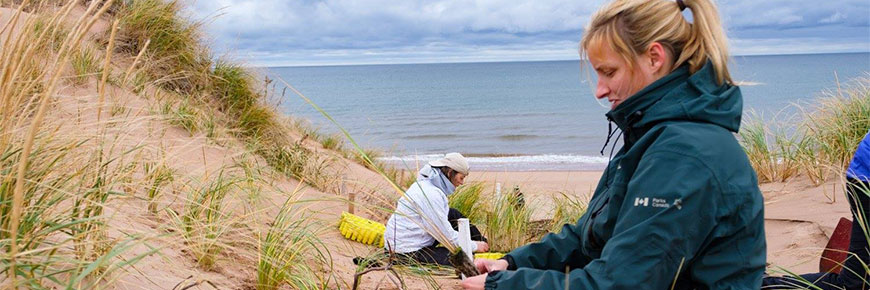
Conserving and restoring ecosystems
Prince Edward Island National Park
Canada's national parks protect and preserve our natural heritage for the benefit of all Canadians, now and in the future. Our national parks are home to innumerable wild plants and animals, some of which are in danger of extinction. By keeping their habitats safe and intact, we can all help to ensure their future.
Our primary objective is to ensure “ecological integrity.” This means that we want to keep our national park ecosystems healthy. An ecosystem is formed by the interaction of all living things with one another and with their habitat in a particular environment. Ecosystems are complex and constantly changing. People are an integral part of natural ecosystems; keeping them healthy helps to enhance the quality of our lives as well.
Regular conservation activities in PEI National Park include:
- Endangered species monitoring and management.
- Management tools to aid in the conservation and recovery of these species when possible (such as beach closures and camera surveillance of predator threats for piping plover).
- Restoring dune blowouts by placing discarded Christmas trees to capture sand and planting marram grass.
- Monitoring and managing invasive species to give native species in the forest and wetlands a chance to grow increasing biodiversity.
- Monitoring fresh and wetland water systems can identify unhealthy conditions which may be able to be addressed.
- Basic Impact Assessments (BIA) for all projects, consulting on indigenous and cultural resources.
- Prevention and Law Enforcement team protection efforts, such as rope and T-bar on beaches to protect our very fragile dune system with designated beach access. This minimizes trampling on marram grass, which holds the dunes together.

Conservation and Restoration (CoRE)
Conservation and Restoration (CoRe) is a Parks Canada funding program to improve the ecological health of ecosystems in national parks. Projects are designed to improve ecosystems while at the same time engaging the public and enhancing opportunities for visitor experience. This investment supports conservation efforts that will ensure these cherished places are protected and secured for the future.
Indigenous partners continue to play an important role in CoRe projects. Their experience and knowledge of the land have been valuable in designing projects.

Acadian Forest Restoration
PEI National Park has been participating in this program since 2008. One of the PEI National Parks longest ongoing CoRe projects is the Acadian Forest Restoration.
Watch our video, If a Tree Falls in the Forest: Restoring the Acadian Forest in PEI National Park, to learn more about efforts to restore Acadian forest species to the woodlands of Prince Edward Island National Park.
Before the establishment of the park in 1937, much of the land had been previously cleared for agricultural use. Over time, these fields have regenerated into a monoculture of white spruce, which is in quick decline as it reaches the end of its natural lifecycle.
The majority of forest stands in PEINP lack the biodiversity of a historical Acadian forest, which typically includes a healthy mixture of American beech, sugar maple, yellow birch, red spruce, and white Pine, all at various ages. This overall deficiency in tree and shrub species diversity is of immediate ecological concern, and is the main issue being addressed CoRe.
Our work involves creating small openings in the white spruce canopy, and filling these openings with a mixture of under-represented species. These techniques mimic natural forest gap progression created by wind, fire, pests, or natural mortality.
Retaining and enhancing other stand features that promote biodiversity is also a priority for all forest restoration work. Cavity trees, coarse woody debris, snags, and legacy trees are all important parts of a healthy forest.
The true success for this project won't be realised for another 40 years or so, when our planted trees start producing seed and regenerating naturally; but setting the stage for future sustainability is a key objective.
Additional PEI National Park CoRe projects include:
- Infrastructure removal.
- Returning Cavendish Grove to a natural oasis.
- Ensuring connectivity in freshwater systems (culverts).
- Date modified :